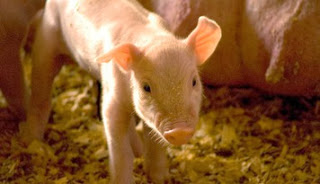Scientists are one step closer to creating a real-life version of Dr. Seuss’ green eggs and ham, thanks to the birth of ten transgenic pigs in late December that glow green when placed under a black light.
 Zhenfang Wu and Zicong Li of the South China Agricultural University used a technique developed by reproductive scientists from the University of Hawaii at Manoa’s John A. Burns School of Medicine to transfer plasmids (small DNA molecules, separate from the chromosomal DNA within a cell) carrying a fluorescent protein from jellyfish DNA into the pig embryos.
Zhenfang Wu and Zicong Li of the South China Agricultural University used a technique developed by reproductive scientists from the University of Hawaii at Manoa’s John A. Burns School of Medicine to transfer plasmids (small DNA molecules, separate from the chromosomal DNA within a cell) carrying a fluorescent protein from jellyfish DNA into the pig embryos.
Assisted by Dr. Johann Urschitz, an assistant research professor at the University of Hawaii’s Institute for Biogenesis Research (IBR), the team of doctors were able to quadruple the success rate of the plasmid transfer — a feat that bodes well for the technique’s overall goal of introducing beneficial genes into larger animals to create more cost-efficient medicines.
This method of transferring DNA from another organism, known as transgenesis, relies on the embryo’s DNA repair machinery to integrate the transferred transgene DNA (in this case, the fluorescent protein from jellyfish) and transmit that property to its offspring.
Because all organisms share a similar genetic code, scientists can cut DNA sequences that code for a particular protein and insert it into other organisms to produce that specific protein. In transgenesis, the scientists insert the altered DNA into the host’s embryo and the desired DNA becomes incorporated, gaining the ability to produce the new protein (again, in this case, the jellyfish protein). This can be applicable in the production of cheaper medicine — pharming, as it is known, which uses the same process, but inserts genes that code for pharmaceuticals into host animals that don’t express those genes naturally (the anticoagulant ATryn, for example, is produced from the milk of genetically modified goats).
“We can make those enzymes a lot cheaper in animals rather than a factory that will cost millions of dollars to build,” said Dr. Stefan Moisyadi, a bioscientist at the IBR.
According to a statement released by the University of Hawaii at Manoa, the additional green glow does not harm the pigs; instead, it just indicates that the transfer succeeded.
“It’s just a marker to show that we can take a gene that was not originally present in the animal and now exists in it,” Moisyadi said.
This isn’t the first instance of glowing green mammals. Last August, scientists from the University of Istanbul, assisted by Dr. Moisyadi, also used this technique to produce the world’s first green rabbits. The same scientists at the university are expected to make an announcement about their results involving sheep and the first transgenic lamb later this year.